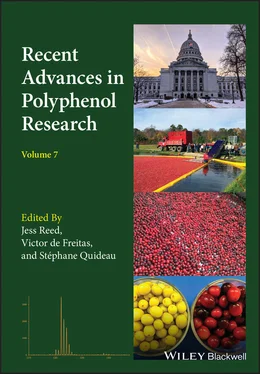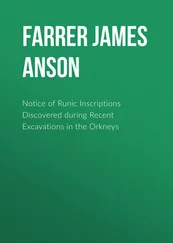Recent Advances in Polyphenol Research
Здесь есть возможность читать онлайн «Recent Advances in Polyphenol Research» — ознакомительный отрывок электронной книги совершенно бесплатно, а после прочтения отрывка купить полную версию. В некоторых случаях можно слушать аудио, скачать через торрент в формате fb2 и присутствует краткое содержание. Жанр: unrecognised, на английском языке. Описание произведения, (предисловие) а так же отзывы посетителей доступны на портале библиотеки ЛибКат.
- Название:Recent Advances in Polyphenol Research
- Автор:
- Жанр:
- Год:неизвестен
- ISBN:нет данных
- Рейтинг книги:5 / 5. Голосов: 1
-
Избранное:Добавить в избранное
- Отзывы:
-
Ваша оценка:
- 100
- 1
- 2
- 3
- 4
- 5
Recent Advances in Polyphenol Research: краткое содержание, описание и аннотация
Предлагаем к чтению аннотацию, описание, краткое содержание или предисловие (зависит от того, что написал сам автор книги «Recent Advances in Polyphenol Research»). Если вы не нашли необходимую информацию о книге — напишите в комментариях, мы постараемся отыскать её.
Recent Advances in Polyphenol Research
Recent Advances in Polyphenol Research — читать онлайн ознакомительный отрывок
Ниже представлен текст книги, разбитый по страницам. Система сохранения места последней прочитанной страницы, позволяет с удобством читать онлайн бесплатно книгу «Recent Advances in Polyphenol Research», без необходимости каждый раз заново искать на чём Вы остановились. Поставьте закладку, и сможете в любой момент перейти на страницу, на которой закончили чтение.
Интервал:
Закладка:
Registered Office(s) John Wiley & Sons, Inc., 111 River Street, Hoboken, NJ 07030, USA John Wiley & Sons Ltd, The Atrium, Southern Gate, Chichester, West Sussex, PO19 8SQ, UK
Editorial Office The Atrium, Southern Gate, Chichester, West Sussex, PO19 8SQ, UK
For details of our global editorial offices, customer services, and more information about Wiley products visit us at www.wiley.com.
Wiley also publishes its books in a variety of electronic formats and by print‐on‐demand. Some content that appears in standard print versions of this book may not be available in other formats.
Limit of Liability/Disclaimer of Warranty While the publisher and authors have used their best efforts in preparing this work, they make no representations or warranties with respect to the accuracy or completeness of the contents of this work and specifically disclaim all warranties, including without limitation any implied warranties of merchantability or fitness for a particular purpose. No warranty may be created or extended by sales representatives, written sales materials or promotional statements for this work. The fact that an organization, website, or product is referred to in this work as a citation and/or potential source of further information does not mean that the publisher and authors endorse the information or services the organization, website, or product may provide or recommendations it may make. This work is sold with the understanding that the publisher is not engaged in rendering professional services. The advice and strategies contained herein may not be suitable for your situation. You should consult with a specialist where appropriate. Further, readers should be aware that websites listed in this work may have changed or disappeared between when this work was written and when it is read. Neither the publisher nor authors shall be liable for any loss of profit or any other commercial damages, including but not limited to special, incidental, consequential, or other damages.
Library of Congress Cataloging‐in‐Publication data applied for
ISBN: 9781119545927
ISSN: 2474‐7696
Cover Design: Wiley
Cover Images: © Reed Research Group
Contributors
Nick W. Albert Plant & Food Research, Palmerston North, New Zealand
C. Peter Constabel Centre for Forest Biology and Biology Department, University of Victoria, Victoria, Canada
Kevin M. Davies Plant & Food Research, Palmerston North, New Zealand
Kriya Dunlap Department of Biochemistry, University of Alaska Fairbanks, Fairbanks, USA
Daniel Esquivel‐Alvarado Department of Animal Sciences, University of Wisconsin–Madison, Madison, USA
Ana Gutiérrez Instituto de Recursos Naturales y Agrobiología de Sevilla (IRNAS), CSIC, Seville, Spain
Rubina Jibran Plant & Food Research, Palmerston North, New Zealand
James A. Kennedy Functional Phenolics, LLC, Corvallis, USA
Christian G. Krueger Complete Phytochemical Solutions LLC, Cambridge, Wisconsin, USA Department of Animal Sciences, University of Wisconsin–Madison, Madison, USA
Hoon Kim Department of Energy Great Lakes Bioenergy Research Center, Wisconsin Energy Institute University of Wisconsin–Madison, Madison, USA
Wu Lan Department of Biological System Engineering University of Wisconsin–Madison, Madison, USA & Department of Energy Great Lakes Bioenergy Research Center, Wisconsin Energy Institute University of Wisconsin–Madison, Madison, USA
Mary Ann Lila Department of Food Bioprocessing and Nutrition Sciences, Plants for Human Health Institute, North Carolina State University, Kannapolis, USA
Richard L. Lindroth Department of Entomology, University of Wisconsin–Madison, Madison, USA
Dawei Ma Centre for Forest Biology and Biology Department, University of Victoria, Victoria, Canada
Johan Mendoza Department of Chemistry, Nova School of Science and Technology, Caparica Portugal
Irene Mueller‐Harvey School of Agriculture, Policy and Development, University of Reading, Reading, UK
Ken Ohmori Department of Chemistry, Tokyo Institute of Technology, Tokyo, Japan
Marisa S. Otegui Department of Botany, University of Wisconsin–Madison, Madison, USA
Fernando Pina Department of Chemistry, Nova School of Science and Technology, Caparica, Portugal
John Ralph Department of Energy Great Lakes Bioenergy Research Center, Wisconsin Energy Institute, University of Wisconsin–Madison, Madison, USA & Department of Biochemistry, University of Wisconsin–Madison, Madison, USA
Jess Dreher Reed Department of Animal Sciences, University of Wisconsin–Madison, Madison, USAComplete Phytochemical Solutions LLC, Cambridge, Wisconsin, USA
Jorge Rencoret Instituto de Recursos Naturales y Agrobiología de Sevilla (IRNAS), CSIC, Seville, Spain
José C. del Río Instituto de Recursos Naturales y Agrobiología de Sevilla (IRNAS), CSIC, Seville, Spain
Kennedy F. Rubert‐Nason Division of Natural and Behavioral Sciences University of Maine–Fort Kent, Fort Kent, USA
Kathy E. Schwinn Plant & Food Research, Palmerston North, New Zealand
Keisuke Suzuki Department of Chemistry, Tokyo Institute of Technology, Tokyo, Japan
Wayne E. Zeller ARS‐USDA, U.S. Dairy Forage Research Center, Madison, USA
Yanfei Zhou Plant & Food Research, Palmerston North, New Zealand
Preface
Every two years, Groupe Polyphénols (GP) hosts the International Conference on Polyphenols (ICP). The XXIX ICP was the first one to be held in the United States in Madison, Wisconsin, on the campus of the University of Wisconsin–Madison (UW–Madison), from July 16 to 20, 2018. Groupe Polyphénols also hosted the 9 thTannin Conference (TC) concurrently with the XXIX ICP. Groupe Polyphénols was founded in 1972 and is the world’s premier society of scientists in the fields of polyphenol chemistry, synthesis, bioactivity, nutrition, industrial applications, and ecology.
Madison is Wisconsin’s state capital (the capitol building is shown on the front cover) and one of the nicest cities in the great lakes region. UW–Madison is a top ranked University (25 thworldwide and 19 thin the USA) and has a lovely campus with miles of lakefront and beautiful scenery adjacent to the state capitol. This venue for the XXIX ICP and 9 thTC was fitting because Wisconsin’s cranberry industry provides 60 percent of the world’s supply of cranberries and is the state’s largest fruit industry. The cranberry industry is also strongly dependent on the polyphenolic composition of the fruit. Cranberries are harvested in the fall after they turn from yellow‐green to bright red, as shown on the front cover. The fruits are harvested by flooding the marsh (also called cranberry bogs). After removing the fruits from the vine, they float to the surface and are corralled with a floating boom and conveyed into trucks (as depicted on the front cover). The fruits are either transferred to a packaging facility for the fresh fruit market or to a frozen storage facility for subsequent processing into juice or sweetened dried cranberries (SDC). In both cases the bright red color of the fruit is a critical component of processing because the fruit is sorted based on color before packaging as fresh fruit or processing for juice and SDC (a processing line after sorting is also shown on the front cover). The color is a function of six anthocyanins, cyanidin 3‐O‐galactoside, cyanidin 3‐O‐glucoside, cyanidin 3‐O‐arabinoside, peonidin 3‐O‐galactoside, peonidin 3‐O‐glucoside, and peonidin 3‐O‐arabinoside. In addition to the anthocyanins, cranberries contain a large diversity of other monomeric polyphenols, especially flavonol glycosides, and contain simple phenols such as hydroxycinnamic acids and hydroxybenzoic acids. Cranberries also contain proanthocyanidins, which are just as important to the economic value of the fruit as the anthocyanins. The importance of proanthocyanidins to the cranberry market is a result of pioneering research from the late 1990s in which “A‐type” interflavan bonds were discovered to be the structural feature of cranberry proanthocyanidins that is associated with the prevention of adherence of P‐fimbriated E. coli to uroepithelial cells, the putative mechanism in the prevention of urinary tract infections. Proanthocyanidin content is now used to market cranberry products (including juice, sweetened dried cranberries, and dietary supplements) and consumers widely recognize cranberries as healthy. Therefore, all of the subjects that were discussed at the XXIX ICP and 9 thTC and the chapters of this volume of Recent Advances in Polyphenol Research are of direct importance to Wisconsin’s cranberry industry. The role of polyphenols in this industry is an excellent example of the importance of polyphenol research in general.
Читать дальшеИнтервал:
Закладка:
Похожие книги на «Recent Advances in Polyphenol Research»
Представляем Вашему вниманию похожие книги на «Recent Advances in Polyphenol Research» списком для выбора. Мы отобрали схожую по названию и смыслу литературу в надежде предоставить читателям больше вариантов отыскать новые, интересные, ещё непрочитанные произведения.
Обсуждение, отзывы о книге «Recent Advances in Polyphenol Research» и просто собственные мнения читателей. Оставьте ваши комментарии, напишите, что Вы думаете о произведении, его смысле или главных героях. Укажите что конкретно понравилось, а что нет, и почему Вы так считаете.












